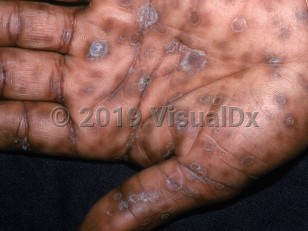Secondary syphilis - Anogenital in
See also in: Overview,Hair and Scalp,Oral Mucosal LesionSynopsis

Secondary syphilis is the second stage of the infection caused by the spirochete Treponema pallidum, which has spread hematogenously throughout the entire body. It typically occurs 3-10 weeks after the appearance of the primary syphilitic chancre.
Secondary syphilis can present with varied manifestations. Patients generally develop constitutional symptoms including malaise, appetite loss, fever, headache, stiff neck, myalgias, pharyngitis, and flu-like symptoms. Generalized lymphadenopathy is typically present. Cutaneous manifestations of secondary syphilis may include a generalized rash that typically includes the palms and soles. Patchy alopecia or telogen effluvium can be present. Rheumatologic manifestations are reported in a minority of patients. Gastric ulcers may occur. Ocular symptoms may include lacrimation, photophobia, and red, painful eyes.
The second stage of syphilis is manifested in the genital area with moist, hypertrophic, papular lesions known as condylomata lata. These lesions can be hyperplastic or verrucous and often look like condylomata acuminata. Condyloma lata can occur adjacent to the site of the primary chancre, especially in immunocompromised individuals. They are teeming with spirochetes and are, therefore, extremely infectious. Uncommonly in the genital area, there can be mucous patches, which are nonspecific, superficial erosions. There may be multiple anogenital lesions, and they may be painful.
The lesions of secondary syphilis resolve in 3-12 weeks, with or without treatment. If left untreated, up to 25% of patients will relapse within the first 2 years.
Per the US Centers for Disease Control and Prevention (CDC), the majority of reported male primary and secondary syphilis cases where sex of sex partner is known are among men who have sex with men. An increased incidence of syphilis is associated with HIV positivity.
Immunocompromised patient considerations: HIV infection can alter the clinical presentation of syphilis. Manifestations include multiple chancres, atypical cutaneous eruptions, increased severity of organ involvement (such as hepatitis and glomerulonephritis), and rapidly developing arteritis and neurosyphilis. Neurosyphilis can occur at any stage of syphilis.
Related topics: primary syphilis, tertiary syphilis, early congenital syphilis, late congenital syphilis, ocular syphilis
Codes
A51.39 – Other secondary syphilis of skin
SNOMEDCT:
240557004 – Secondary syphilis
Look For
Subscription Required
Diagnostic Pearls
Subscription Required
Differential Diagnosis & Pitfalls

Subscription Required
Best Tests
Subscription Required
Management Pearls
Subscription Required
Therapy
Subscription Required
References
Subscription Required
Last Updated:07/31/2024
 Patient Information for Secondary syphilis - Anogenital in
Patient Information for Secondary syphilis - Anogenital in - Improve treatment compliance
- Reduce after-hours questions
- Increase patient engagement and satisfaction
- Written in clear, easy-to-understand language. No confusing jargon.
- Available in English and Spanish
- Print out or email directly to your patient



